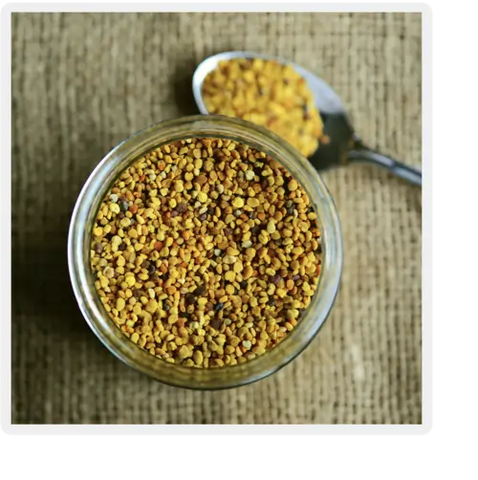
When most of us think of products from a hive, we automatically think of honey—but there are in fact other, lesser known bee byproducts. Among them are pollen, propolis, royal jelly and venom. Have you heard of these products before? Do you know their importance to the hive? Let’s take a closer look at each product so you may better appreciate bees and their work.
Let's dive in!
Pollen
Aside from honey, pollen might be the next product that pops into your mind when you think of products of the hive. It is stored in the chambers of the hives once foraging bees collect the pollen and bring it back to the hive. Pollen plays an important role in honey production as it provides a protein source to new adult bees. Without pollen, there would be no baby bees.
Propolis
Bees collect resin from trees such as cottonwood, birch, alder and poplar. From this resin, they create propolis to seal and protect the cells of the hive and help support the structure of it. If it weren't for propolis, their hives would be more susceptible to viruses and bacteria, as well as wood decay, fungus and water. Propolis is also used as a glue in the hive—to seal drafts and make the hive airtight so that an even temperature is maintained all year round.
 Royal Jelly
Royal Jelly
Royal jelly is made up of mostly water, and a combination of proteins and sugars, as well as small quantities of vitamin C and various minerals and enzymes. This is the developing queen bee's exclusive food. However, early on, all bee larvae are fed royal jelly. It is whiter than honey, and is produced in the glands of worker bees.
Venom
Arguably the least desired product of the hive (from a human perspective), but what you may not know is that venom has been used to treat arthritis and other conditions.
Honey bees will only attack if they feel threatened—using their venom is a last resort. It’s the “guard bees”—those at the end of their life—who are the ones to sting. Although venom is made up of 88% water, bee stings are incredibly painful because humans have a lot of moist tissue, allowing the venom to be incredibly effective.
As most of us know, once a honey bee stings, the venom sac and stinger of the bee are torn from the abdomen and the bee dies. But, the venom keeps pumping into the victim which is why it's so important to take the stinger out immediately.
Handiwork of the Hive
These four products of the hive are fascinating because they each do their part in contributing to colony life, as well as allowing humans to make use of them in many ways.
Contact us today to learn more about the diverse products of bees and the benefits of adding those products into our daily lives.
View our products to see the handiwork of the hive!


Leave a comment